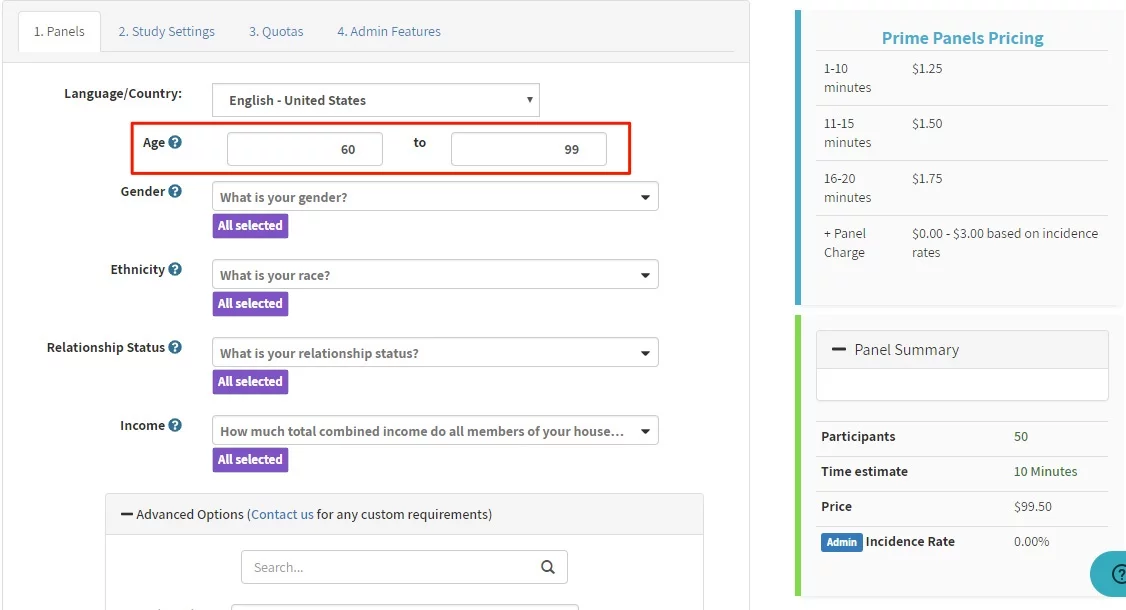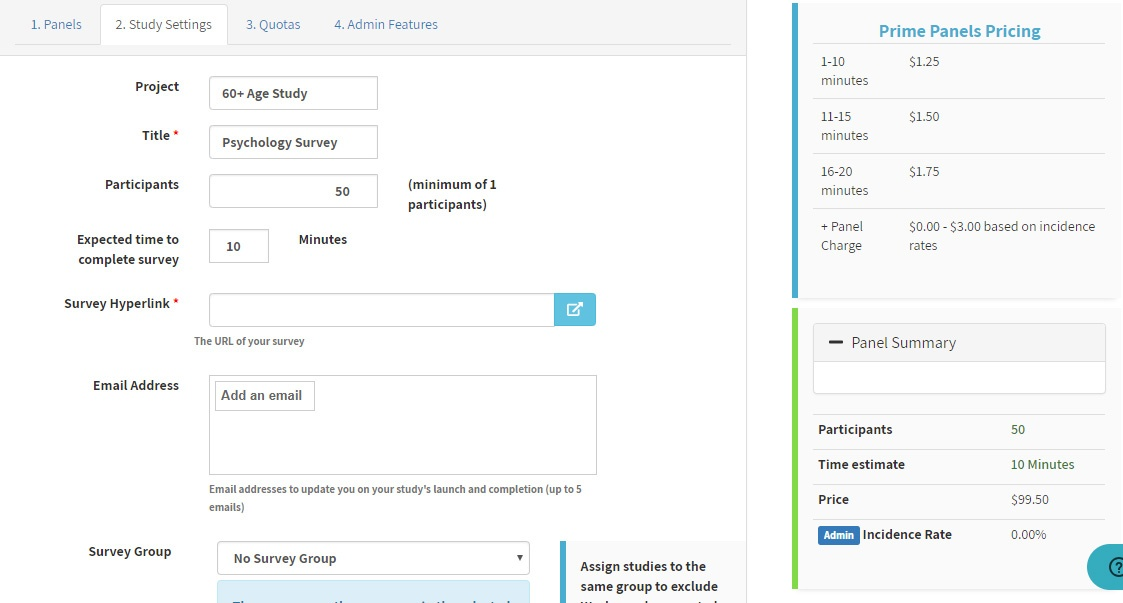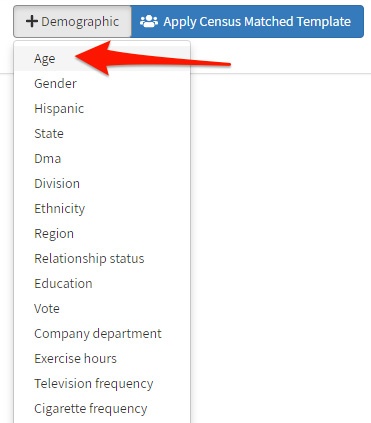Recruiting Older Adults Online

By Richa Gautam, Tommy Roggina, Aaron Moss, PhD, & Leib Litman, PhD
Sampling by Age: Why do it?
People of different ages vary greatly in their beliefs and behaviors. For example, a recent Pew report outlines wide generational gaps in people’s opinions on several political issues like presidential job approval, perceptions of racism, views on immigration, and political ideology (Pew Research Center, 2018). Furthermore, some issues, like the use of Medicare, depend on age and therefore are more relevant to older adults than younger ones. For researchers who study such questions, not being able to recruit enough older participants may decrease the generalizability of their findings. While considering the age of participants is less common in social research than other areas of research, researchers who seek to recruit older adults online may find themselves hindered by the small number of older adults available. So, what can researchers do to recruit older adults in online social research?
Recruiting Older Adults: The Challenge
Recruiting older adults is tricky because they do not frequent the spaces where researchers generally conduct research—they are not on college campuses, they are less likely to travel to labs for paid research opportunities, and they spend less time online than younger adults. Even polling older adults over the phone can be more difficult than polling younger adults (Pew Research Center, 2009).
Recruiting older adults online presents a bit of a paradox. On the one hand it is easier to participate in online research, so inconvenience to the participant is smaller. On the other hand, however, the benefits of participating in online research are also low. Reviews of clinical strategies for recruiting older adults point out that participation increases when participants are provided with free services (McHenry et al., 2012; Michelet et al., 2014), something that is hard to do in online research.
On the bright side, internet use amongst older adults has been steadily rising, reaching 67% in 2017 (Pew Research Center, 2017). This increase brings with it an opportunity to recruit older adults more widely in online research. And at CloudResearch, we offer multiple options for recruiting older adults.
Amazon’s Mechanical Turk
Amazon’s Mechanical Turk (MTurk) is widely used in social research, yet the age of MTurk workers is highly skewed relative to the US population. Internal data from CloudResearch’s database of over 200,000 MTurk workers shows that 67.1% of workers are between the ages of 18 to 40, 27.1% are in their 40’s and 50’s, and 5.8% are above the age of 60 (see Table 1 below). Since about 80,000 to 85,000 workers are active on MTurk in any given year, obtaining a sample of older adults is possible, but getting a large sample of participants over age 60 is very difficult. Further, the scarcity of older workers on MTurk raises some questions about whether the older adults on MTurk differ in important ways from older adults not on MTurk—a concern that is less relevant for younger workers (Huff & Tingley, 2015).
Nevertheless, researchers have used MTurk to obtain samples more diverse in age than their traditional subject pool (Joslyn & LeClerc, 2016). When running a study using CloudResearch’s MTurk Toolkit, you can select an age range for your participants.
To do this go to the MTurk Toolkit and select Tab 1 Panel Options (Optional).

Next scroll down and select the age range you would like to target.
On the right hand side, we will tell you whether the age group you are looking for is feasible to sample on MTurk.
Please note that targeting by age may incur panel fees. Please see the right hand side of the screen, under feasibility, for pricing details.

We determine workers’ ages by asking them their date of birth on different occasions and then determining response consistency. Workers who consistently report the same age are given a qualification that makes them eligible for studies targeting participants of a certain age group. So, when you choose an age panel for your study, you can be confident that your participants are indeed the age they say they are.
Prime Panels
Prime Panels is a large source of online participants, offering access to over 30 million research participants around the world. While just about 6% of workers on MTurk are above age 60, around 26% of Prime Panels participants in the US are above the age of 60 (Table 1). The distribution of age on Prime Panels is much closer to the national average, meaning that millions of older participants are available on Prime Panels making it an ideal supplement to MTurk for online research with the hard to reach elderly population or across the lifespan.
To set up a Prime Panels Survey with Age qualifications, first, go the Create a Study drop-down menu on the top of the CloudResearch page, and, from the drop-down menu, please select Prime Panels.

You will be taken to the Prime Panels page. Next, please scroll down to view the first set up Tab, “Panels.” From here you can select the age range you would like to sample from.

After selecting your targeting criteria, move on to Tab 2, “Study Settings”. Here you will provide: the name of your project, the title viewable to participants, the number of participants you would like to survey, how long you expect the study to take, and the shareable URL to your survey.

In Tab 3 “Quotas”, you may create quotas for your study.

Lastly, click the Save button in the right-hand corner and you should now see your Prime Panels study on your study dashboard.
Congratulations, you have just created a Prime Panels Study with Age qualifications!
One benefit of online research is that it opens doors to demographics underrepresented in traditional research pools. The ability to recruit participants across the lifespan, to control for age, and explore the moderating effects of age, are great examples of the methodological benefits that online research has to offer. At CloudResearch, we take pride in ensuring that you are able to recruit from these demographics seamlessly and confidently.
Table 1: Basic demographics for the MTurk, Prime Panels, and ANES samples
| Age | MTurk | Prime Panels | U.S. Census* |
|---|---|---|---|
| 18-39 | 67.1% | 42.6% | 36.2% |
| 40-59 | 27.1% | 31.5% | 34.5% |
| 60+ | 5.8% | 25.9% | 29.3% |
*Census data has been adjusted to show proportion of age cohorts in the adult population only
Recruiting Participants by Income
We recently published a blog discussing How to Obtain a Sample That is Stratified by Income. Please read that for further details.
References
Census Reporter.
Huff, C., & Tingley, D. (2015). “Who are these people?” Evaluating the demographic characteristics and political preferences of MTurk survey respondents. Research & Politics, 2(3), 2053168015604648.
Joslyn, S. L., & LeClerc, J. E. (2016). Climate projections and uncertainty communication. Topics in cognitive science, 8(1), 222-241.
McHenry, J. C., Insel, K. C., Einstein, G. O., Vidrine, A. N., Koerner, K. M., & Morrow, D. G. (2012). Recruitment of older adults: Success may be in the details. The Gerontologist, 55(5), 845-853.
Michelet, M., Lund, A., & Sveen, U. (2014). Strategies to recruit and retain older adults in intervention studies: a quantitative comparative study. Archives of gerontology and geriatrics, 59(1), 25-31.
Pew Research Center, 2009. Growing Old in America: Expectations vs. Reality. Retrieved from http://www.pewsocialtrends.org/2009/06/29/growing-old-in-america-expectations-vs-reality/
Pew Research Center, 2017. The Generation Gap in American Politics. Retrieved from http://www.people-press.org/2018/03/01/the-generation-gap-in-american-politics/
Pew Research Center, 2018. Tech Adoption Climbs Among Older Adults. Retrieved from http://www.pewinternet.org/2017/05/17/tech-adoption-climbs-among-older-adults/
Weil, J., Mendoza, A. N., & McGavin, E. (2017). Recruiting older adults as participants in applied social research: Applying and evaluating approaches from clinical studies. Educational Gerontology, 43(12), 662-673.
Gautam, R., Roggina, T., Moss, A. J., & Litman, L. (2018, Nov. 21). Recruiting older adults online [blog post]. Retrieved from https://www.cloudresearch.com/resources/blog/recruiting-older-adults-online/

